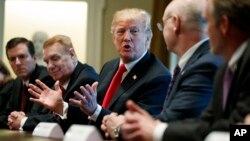In agitating for a trade war, President Donald Trump may have forgotten William Tecumseh Sherman’s adage that “war is hell.”
The Civil War general’s observation can be apt for trade wars, which may create conditions for a shooting war.
A look at Trump’s spoiling-for-a-fight tweet Friday:
TRUMP: “When a country (USA) is losing many billions of dollars on trade with virtually every country it does business with, trade wars are good, and easy to win. Example, when we are down $100 billion with a certain country and they get cute, don’t trade anymore-we win big. It’s easy!”
THE FACTS: History suggests that trade wars are not easy.
The president’s argument, in essence, is that high tariffs will force other countries to relent quickly on what he sees as unfair trading practices, and that will wipe out the trade gap and create factory jobs. That’s his motivation for announcing that the U.S. will impose tariffs of 25 percent on steel imports and 10 percent on aluminum imports.
The record shows that tariffs, while they may help certain domestic manufacturers, can come at a broad cost. They can raise prices for consumers and businesses because companies pass on at least some of the higher costs of imported materials to their customers. Winning and losing isn’t as simple a matter as tracking the trade gap.
The State Department’s office of the historian looked at tariffs passed in the 1920s and 1930s to protect farms and other industries that were losing their markets in Europe as the continent recovered from World War I. The U.S. duties hurt Europe and made it harder for those countries to repay their war debts, while exposing farmers and consumers in the U.S. to higher prices. European nations responded by raising their tariffs and the volume of world trade predictably slowed by 1934.
The State Department says the tariffs exacerbated the global effects of the Great Depression while doing nothing to foster political or economic cooperation among countries. This was a diplomatic way of saying that the economic struggles helped embolden extremist politics and geopolitical rivalries before World War II.
Nor have past protectionist measures saved the steel industry, as Trump says his tariffs would.
The United States first became a net importer of steel in 1959, when steelworkers staged a 116-day strike, according to research by Michael O. Moore, a George Washington University economist. After that, U.S. administrations imposed protectionist policies, only to see global competitors adapt and the U.S. share of global steel production decline.









